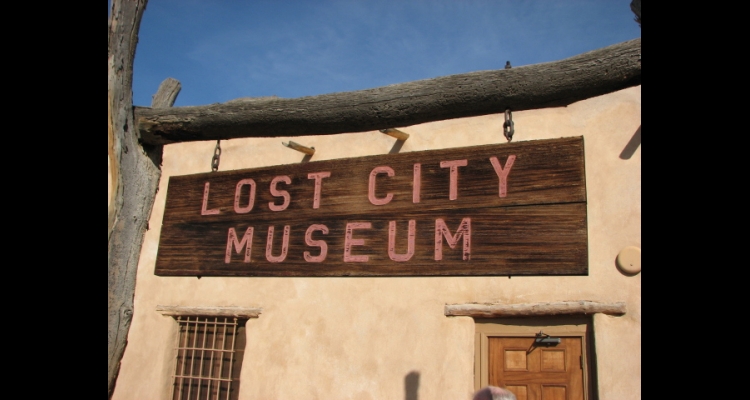Lost City Museum
The Lost City Museum in the town of Overton, Nevada, was built by the U.S. National Park Service and federal Civilian Conservation Corps in 1935 to preserve and display precious artifacts excavated from an area called Pueblo Grande de Nevada, and known as “the Lost City.” For centuries, Native Americans known as the Virgin River group of Ancestral Puebloans, or ancient Anasazi, lived in Southern Nevada in small hamlets until they migrated away more than 850 years ago.
In 1924, brothers John and Fay Perkins found tribal ruins and artifacts near the Muddy River in the Moapa Valley in the Mohave Desert about 65 miles northeast of Las Vegas. Their discovery would lead to an excavation within a six-mile area considered the only large settlement of the Pueblo tribe west of the Colorado River. The excavations, led by pioneer archeologist Dr. Mark Harrington, over the next year revealed the remnants of underground pit houses and multi-room pueblo houses built by the Puebloans. One early group, called the Basketmakers, dwelled there from 300 B.C. to 700 A.D. They resided in below-ground pit houses, wove baskets, grew corn, used atlatls spears to hunt game and later made pottery and hunted with bows and arrows. A second group, split into the Puebloans I and II, engaged in trade with other tribes, built above-ground pueblos, grew crops along the Muddy River and stayed from 700 A.D. to 1150 A.D. The Puebloans began to fashion corrugated pottery around the year 1050 A.D.
The national and local news media in the 1920s and 1930s embraced the story of this hidden civilization, dubbing it “the Lost City.” In the early 1930s, construction of $168 million Hoover Dam near Boulder City about 70 miles to the southwest meant that the Lost City would eventually be submerged under an enormous man-made body of water, Lake Mead. In 1935, as the last of the concrete was poured at the dam site, the park service and CCC were at work on a museum, originally the Boulder Dam Park Museum, to house the collections of native artifacts recovered from the Lost City area. The park service, with a modest $5,900 in funding, backed construction of the museum in a pact with the Southwest Museum of the American Indian in Los Angeles, which paid for the services of Harrington (its curator) as archeologist.
The Lost City Museum, designed by Harrington, was built on a small mesa in Overton that was itself an excavated prehistoric site, containing the ruins of a pueblo. After creating hundreds of sun-dried adobe bricks using ground from the Moapa Valley, the CCC relief workers built the one-story structure, fashioned in the Pueblo Rival style. The preserved ruins of the pueblo served as the center piece inside the museum. The CCC, using designs from the Lost City, then reconstructed life-seized adobe pueblos and a pit house outside the museum. To this day, the pueblos are repaired after rainfall damages the fragile adobe exteriors. The park service turned the museum over to the state of Nevada in 1952. In 1981, the grounds were expanded to protect other excavations. The museum gained entry on the National Register of Historic Places in 1996.
The Lost City Museum’s collection includes a variety of reconstructed, centuries-old Puebloan pottery, including many bowls painted in black and white corrugated designs thought to have started in the Lost City in about the year 1050; carved points for darts and atlatls spears; bows and arrows; a nearly one-foot long obsidian blade; a woven bag and hammer found in a nearby Puebloan salt mine; turquoise jewelry inlayed in gilsonite; necklaces of shell beads used for trading; an array of incised stones (flat stones with carved designs, possibly used for religious purposes); an original woven sandal; stones used for grinding corn, and bone pieces used for playing games. One spear point culled the Lost City excavation is estimated at 13,000 to 13,500 years old.
Also in the museum’s collection are examples of works by the local Southern Paiute tribe, such as a variety of basketry from the 1930s. Museum goers can also view some of the filed note Fay Perkins wrote during excavation work on the Lost City. Photo displays chronicle the history of the excavations, the evolution of geology in Nevada and milestones of modern Nevada history such as the 19th century former Mormon town of St. Thomas that was submerged as well by Lake Mead. The museum also hosts regular exhibits of works from local artists.

